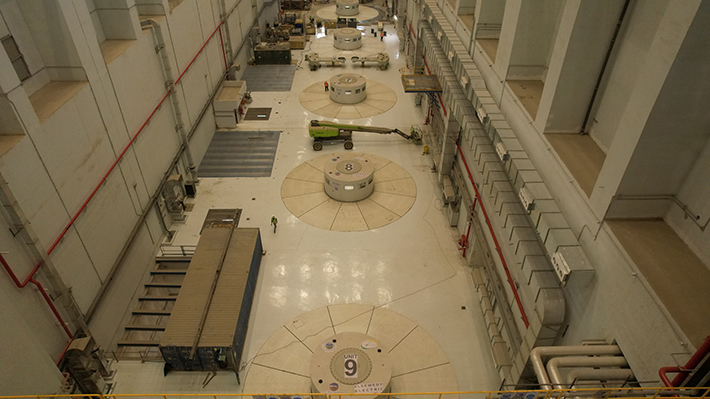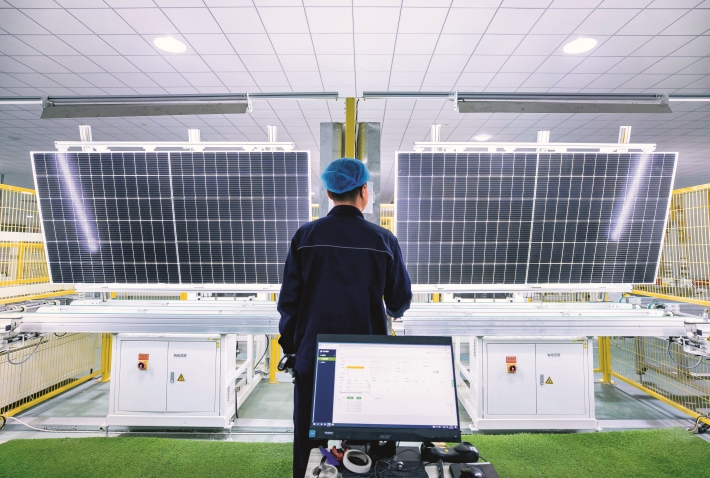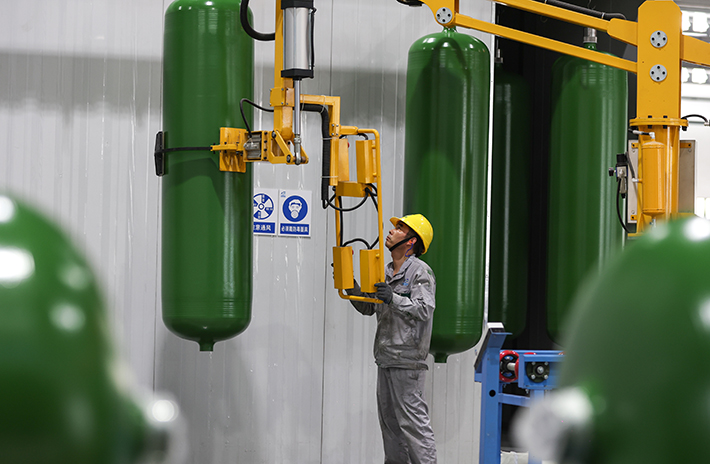|
||||||||||
| Home Top News Economy/Tech Culture/Sports China in Foreign Eyes Green Development Videos Intangible Cultural Heritages |
|
||||||||||
| Home Top News Economy/Tech Culture/Sports China in Foreign Eyes Green Development Videos Intangible Cultural Heritages |
| ChinAfrica |
| Setting Standards |
| From manufacturing equipment to exporting standards, China is powering the world with clean energy |
| By GE LIJUN | VOL. 17 November 2025 ·2025-11-05 |

Chinese company Dongfang Electric Machinery is supplying all the equipment for the Julius Nyerere hydroelectric project in Tanzania (COURTESY)
China’s Dongfang Electric Machinery successfully completed the manufacturing of the first batch of embedded components for six turbines it is supplying for the Koysha Hydroelectric Dam project in Ethiopia. Transported by land and sea, these parts will arrive on site in three months. Once completed, the power plant will generate more than 6 billion kwh of electricity annually, reducing carbon dioxide emissions by 1 million tonnes per year.
Deyang, a city in southwest China’s Sichuan Province and home to Dongfang Electric Machinery, is one of China’s leading centres for clean energy equipment manufacturing. It is estimated that one in every four units of electricity in China is generated using equipment produced in Deyang. In addition, Deyang-made equipment is exported to more than 100 countries and regions, with a total installed capacity exceeding 100 gw.
Amid a global push for energy transition and climate action, demand for clean technology is rising rapidly. Against this backdrop, the third World Conference on Clean Energy Equipment was held in Deyang from 17 to 18 September. Participants explored industry development strategies and a sustainable path for the future of energy.
Clean energy equipment covers key areas such as hydropower, wind power, photovoltaics, nuclear energy, hydrogen, energy storage, smart grids, and high-efficiency transmission. The rapid growth of this sector in China depends on one critical factor: standardisation. Robust standards not only boost industrial competitiveness, but also enhance the global recognition of Chinese technologies.

A technician conducts quality control on photovoltaic products in the module manufacturing workshop of Yingli New Energy (Ningxia) in Wuzhong, Ningxia Hui Autonomous Region, on 23 February 2023 (XINHUA)
Standards at the heart of innovation
According to data presented at the conference, China now has the world’s largest and most comprehensive clean energy equipment chain, accounting for 60 percent of global growth in installed renewable energy capacity. It also supplies 70 percent of the world’s wind power equipment and over 80 percent of its photovoltaic modules. In the first half of 2025, the output value of China’s clean energy equipment industry grew by 18.7 percent year on year.
Xu Niansha, president of the China Machinery Industry Federation, said these figures show that “China has become a key driving force for the stability of global supply chains and the green energy transition.”
Technological innovation has become the primary engine driving this development. From the creation of core equipment to integrated system solutions, China has achieved breakthroughs in strategic areas such as hydrogen storage and transport, smart grid modernisation, and the integration of diverse energy technologies.
This growing technological development has, in turn, led to the formulation of new standards. Among the key achievements presented were the 10 major normative advances in clean energy equipment. In the wind power sector alone, 64 national standards were developed or revised during the 14th Five-Year Plan period (2021-2025), covering equipment design, manufacturing, operation, and maintenance, significantly improving the industry’s overall quality and safety.
Some of these standards are world firsts. For example, the standard for autonomous delivery vehicles has unified testing methods for travel performance, reducing cross-border certification costs. Similarly, the standard for direct current plugs and sockets for domestic and similar uses offers a solution for the final stage of replacing fossil fuels with renewables in building energy consumption.
In the first half of 2025, China nearly doubled its newly installed renewable energy capacity compared to the previous year. According to the General Administration of Customs, exports of the “three new products” - electric vehicles, lithium-ion batteries, and photovoltaic panels - reached 757.8 billion yuan ($106.33 billion), accounting for 4.1 percent of China’s total exports to more than 200 countries and regions. These achievements are supported by a comprehensive regulatory framework crafted within China.

A technician works in the hydrogen tank production workshop of GUOFUHEE in Suzhou, Jiangsu Province, on 31 May 2024 (XINHUA)
Towards a global presence
Amid growing global demand, China’s export advantages are consolidating. “This success rests on a virtuous triad,” Sun Chuanwang, professor at Xiamen University, told China Energy News. He elaborated that technological innovation drives cost reductions, large-scale industrialisation accelerates the commercialisation of innovations, and combined cost and quality advantages promote the export of capabilities and technologies. Together, these dynamics signal a profound shift: China is moving beyond exporting products to becoming a global leader in exporting technologies and standards.
Among the pioneering companies is Guangdong Lyric Robot Automation, which began its international expansion in 2011. It has evolved from exporting finished products to delivering comprehensive solutions that integrate technical design, management standards, and smart manufacturing. Through close collaboration with customers, the company helps to establish new equipment standards, playing a key role in shaping the global new energy sector’s transition.
“Today, the company plays a leading role in process development, product design, and equipment definition. Our production lines delivered to Europe have changed the continent’s perception of the new energy industry,” its co-founder and vice president Lu Jiahong, noted.
According to Xu, China is now aiming to build an integrated export model that combines products, technologies, standards, and services. The country is promoting mutual recognition of standards with the European Union regarding carbon footprint and green certification. Additionally, China is preparing to establish a global alliance of clean energy equipment industries to enhance international cooperation.
By 2022, Dongfang Electric Machinery successfully secured the adoption of Chinese standards for the Julius Nyerere hydroelectric project in Tanzania, leveraging its experience and strong reputation. According to Sichuan Daily, companies in Deyang are actively tailoring their technological standards to align with the unique energy characteristics of partner countries involved in the Belt and Road Initiative, thereby promoting the joint development of wind, solar, and hydropower projects.
Among the 10 major normative advances, several standards have gained global influence. Notably, the standard for the integrated control functions of hydroelectric power plants, cascade power plant groups, and pumped storage power plants addresses a significant international regulatory gap.
A report by the International Renewable Energy Agency states that, over the past decade, the average cost per kwh of solar and wind power has fallen by more than 80 percent and 60 percent respectively, largely driven by the reliability and competitiveness of Chinese equipment.
The China Machinery Industry Federation has noted that China now leads or co-drafts numerous international standards in clean energy equipment. This growing global regulatory influence marks a strategic shift from a “market for technology” model to one focused on “technology-exporting standards.”
|
||||||
| About Us | Contact Us | Advertise with Us | Subscribe |
| Copyright Beijing Review All rights reserved 京ICP备08005356号-5 京公网安备110102005860号 |